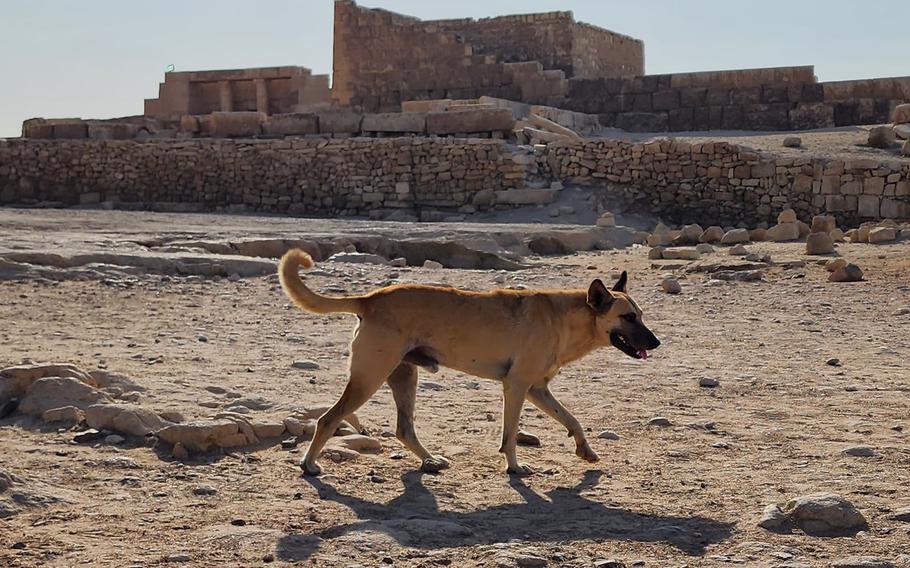
A video of Apollo atop of the Pyramid of Khafre went viral last week. (Vicki Brown/American Cairo Animal Rescue Foundation)
When video of a dog at the top of an Egyptian pyramid in Giza went viral last week, tens of millions of social media users were simultaneously delighted and baffled. How did the dog get up there, and why?
But Ibrahim Elbendary, co-founder of the American Cairo Animal Rescue Foundation, recognized the animal immediately. It was Apollo, one of about eight dogs in a pack that lives on the Pyramid of Khafre’s upper reaches.
Apollo, his siblings and their pack mother, whom locals call Laika — named for a dog who was sent into space in the ’50s — are among dozens of stray dogs at the pyramid complex and millions in Egypt. They are cared for by animal welfare organizations that say they face significant challenges in meeting an enormous need.
Most of the strays at the pyramid complex, which is just outside Cairo, live on the ground or close to it. But Laika ventured toward the pyramid’s top, which Elbendary says may have seemed a protected place to give birth. “She is very smart,” he said. She and her offspring have since made it their home.
It was “the most shocking thing,” he said, to see them hunting birds atop the Pyramid of Khafre, the second tallest of the three main pyramids in Giza. They sneak up on crows and jump into the air to catch them, hundreds of feet from the ground, on the rough stones. Apollo, who Elbendary said is about 3 years old, was barking at birds in Oct. 14 footage filmed by a paraglider.
The rescue organization cares for street dogs and other animals that live in the famed 4,500-year-old pyramid complex and elsewhere, but what the group is able to do is a “drop in the bucket,” said co-founder Vicki Brown.
It provides dogs with food, water and medical care and facilitates adoptions to the United States. It also traps, vaccinates and spays or neuters strays before releasing them — though Apollo “runs directly to the top of the pyramid when we try” and so far has evaded capture, Elbendary said.
The 31-year-old said he is a veteran of the Egyptian army and left the service about seven years ago, traumatized by the bloody fight against the Islamic State in the Sinai Peninsula in the country’s northeast. He was working for an American company but “didn’t feel a meaning to my life” until he started caring for stray dogs.
“I felt like I was making a difference in their life, and they were making a difference in my life,” he said. “… With every case I took from ‘zero to hero,’ as they say, I felt a very big happiness inside my heart.”
By the time he met Brown, 50, from Tennessee, who was in Egypt working on an animal welfare project, he had 25 dogs living in his backyard, he said. They founded the organization in 2020. It has set up a shelter and vet clinic in Cairo and is also registered in the United States.
Estimates vary on the number of street dogs in Egypt, but it’s generally believed there are millions. There are hundreds of thousands of cases of them biting humans each year, contributing to the risk of rabies, according to the U.N. Food and Agriculture Organization.
Violence against the dogs is not unusual, animal welfare advocates say, with occasional high-profile examples that grab the spotlight. In 2016, strangers banded together to transport a Cairo stray named Anubis to the United States for adoption after the top of his mouth had been cut off. The previous year, a graphic photo of a litter of puppies that had been killed on the Cairo streets sparked outrage, Egyptian newspaper al-Ahram reported.
Egyptian Society for Mercy to Animals chair Mona Khalil said in an interview that animal welfare organizations are underfunded, relying on private donations and their founders’ own money, and hampered by a lack of regulations protecting animals in Egypt. Spay-and-neuter programs for street dogs should be much more widespread, she added.
But she, Elbendary and Brown separately said they were thrilled when they saw the video of Apollo at the top of the pyramid shared worldwide.
They hoped it would result in more interest in Cairo’s street dogs and help persuade residents and authorities to take care of them.
“Maybe somebody would finally come out and show us support here,” Khalil said, “so that we would be able to undergo more work for the protection of dogs here in Egypt.”
As for Apollo, he appeared happy and healthy when Brown saw him Monday morning. He had come down from the pyramid to eat food laid out by the foundation — oblivious to his moment of fame.